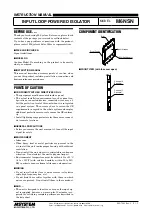2 - 12
INSTALLATION
DECEMBER 2018
32DSSSK06.D
K-SERIES PUBLIC USE SERVICE MANUAL
TABLE 2-1: LIMIT SWITCH ADJUSTMENT CHART
COMPONENT
SYMPTOM
CORRECTIVE
ACTION
ADJUSTMENT PROCEDURE
Up cutoff
adjustment
screw
Lift stops low.
Adjust screw clock-
wise.
Adjust up cutoff switch so that lift stops just
before first knuckle actuator saddle or roller
touches underside of lower parallel arm.
(Saddle or roller should be about 1/8" from
lower parallel arm.)
Lift stops high.
Adjust screw counter-
clockwise.
Deploy cutoff
adjustment
screw
Lift stops low.
Adjust screw counter-
clockwise.
Adjust deploy limit switch so that lift stops
just below "Up" cutoff described in above
step. This will give the necessary overlap
to avoid "dead" spots.
Lift stops high.
Adjust screw clock-
wise.
END OF TABLE
1. PLATFORM
TILT
ADJUSTMENT
Correct platform tilt adjustment is crucial for proper platform rollstop operation, but cannot be adjusted at factory.
Factors such as vehicle floor height, lift tilt angle and stiffness of vehicle springs will vary installation geometry.
a. Deploy and lower lift platform to a position halfway between vehicle floor level and ground level.
b. Refer
to
Figure 2-15
. Adjust left and right platform set screws until platform is level at zero (0) degrees.
Turn setscrews clockwise to angle front-end of platform upward, or counter-clockwise to angle downward.
NOTE:
At ground level, the distance between heel of platform and ground should be 3/4" to 1". This distance
should be measured at initial point of rollstop full deployment.
NOTE:
Adjust setscrews on both sides of platform simultaneously and evenly to ensure proper leveling of platform.
RSM0003400
SET SCREW
S-SERIES TYPE PLATFORM
FIGURE 2-15: PLATFORM SET SCREWS
c. Repeat steps a and b as required to achieve proper rollstop operation.
CAUTION
Do not lengthen tie rod stud to point where panel will lift off its tab support (at center of lift fork).
d. Adjust left tie rod assembly. Adjust tie rod stud until nearly all of link free-play is out by lengthening rod.


















